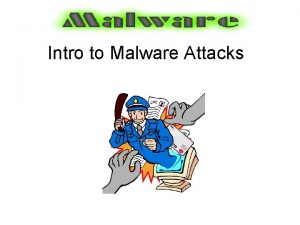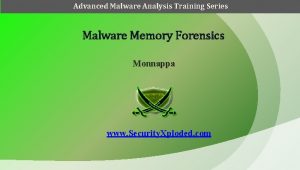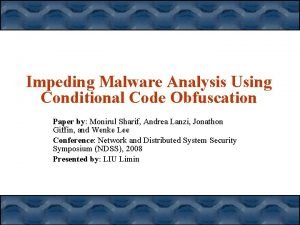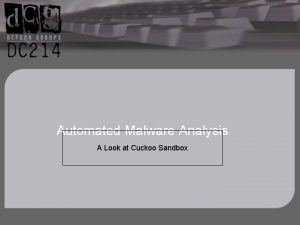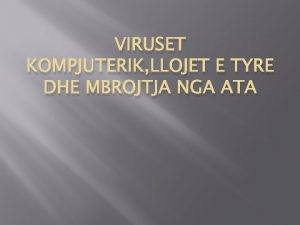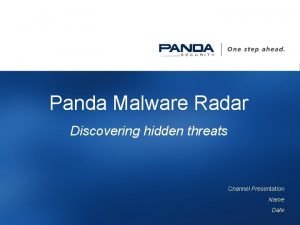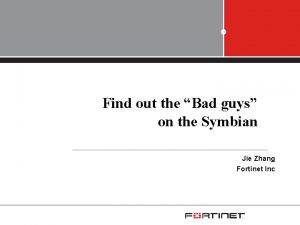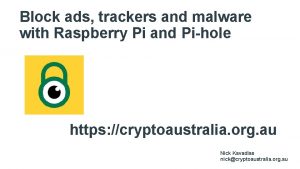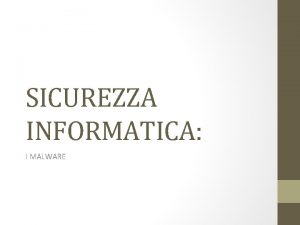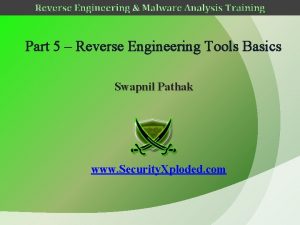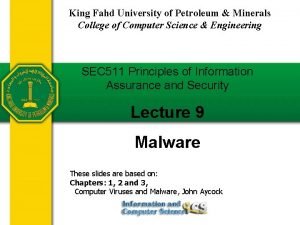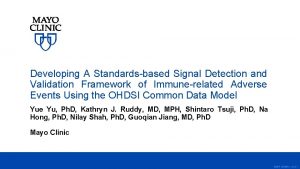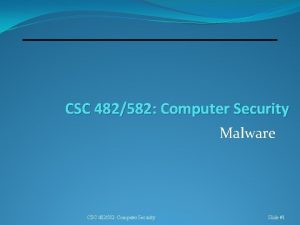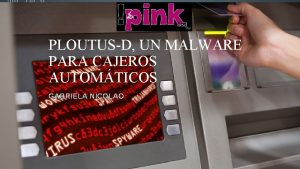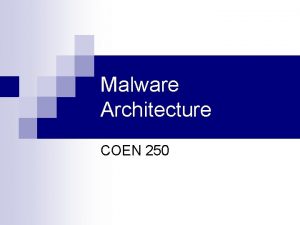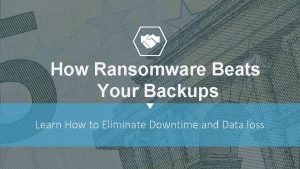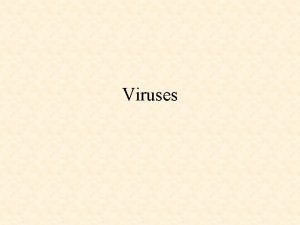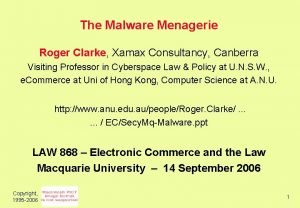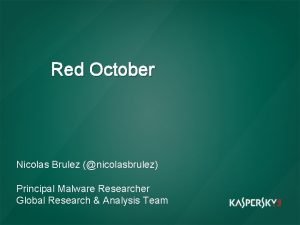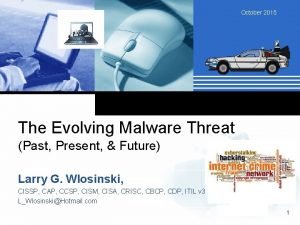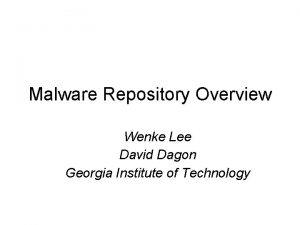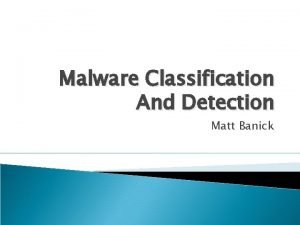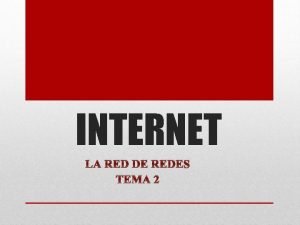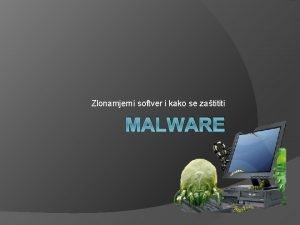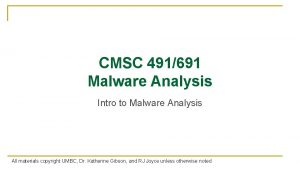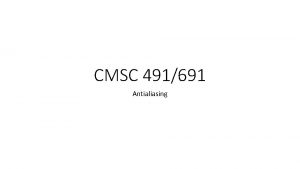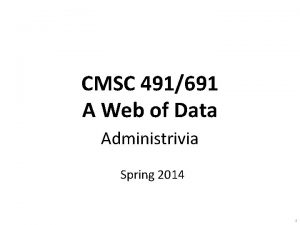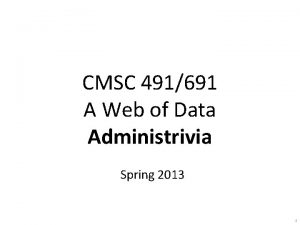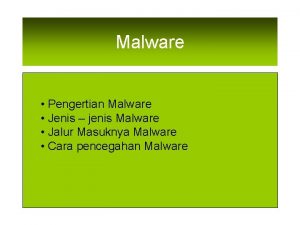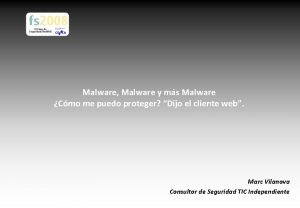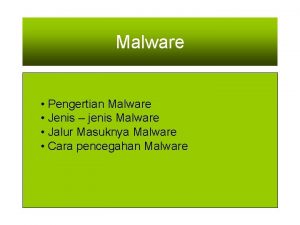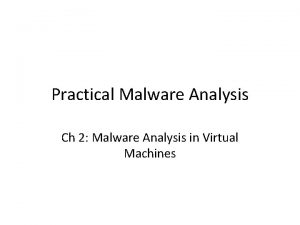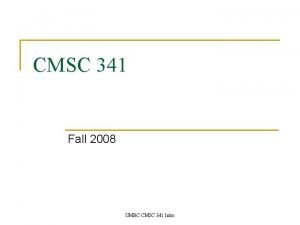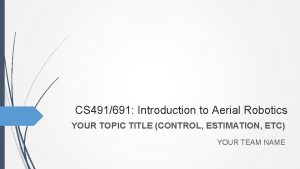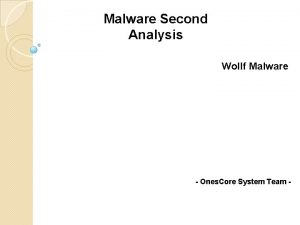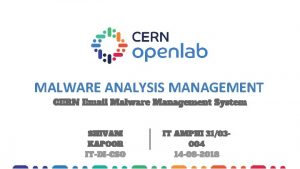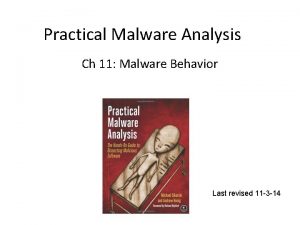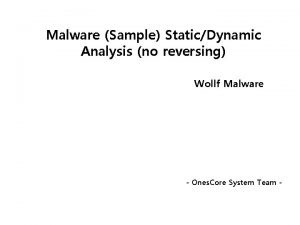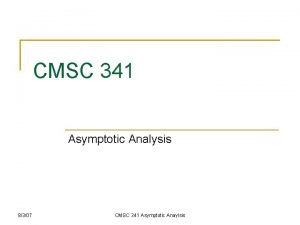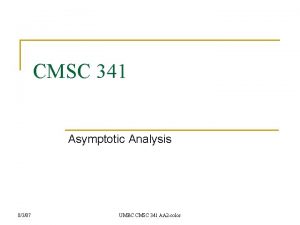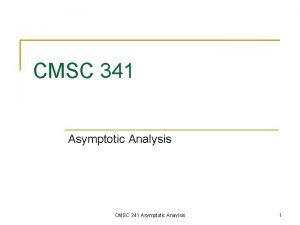CMSC 491691 Malware Analysis Intro to Malware Analysis






























- Slides: 30

CMSC 491/691 Malware Analysis Intro to Malware Analysis All materials copyright UMBC, Dr. Katherine Gibson, and RJ Joyce unless otherwise noted

Topics § Malware detection, classification, attribution § Categories of Malware § Types of Malware Analysis All materials copyright UMBC, Dr. Katherine Gibson, and RJ Joyce unless otherwise noted 2

Malware Detection, Classification, and Attribution All materials copyright UMBC, Dr. Katherine Gibson, and RJ Joyce unless otherwise noted

Malware Detection § Is a given file benign or malicious? § Malicious indicator q Trait of a file that suggests it may not be benign All materials copyright UMBC, Dr. Katherine Gibson, and RJ Joyce unless otherwise noted 4

Malware Classification § Given a malware sample, what category does it belong to? q Will discuss some broad categories of malware soon § What family does the malware sample belong to? q Will also talk about some notable families All materials copyright UMBC, Dr. Katherine Gibson, and RJ Joyce unless otherwise noted 5

Malware Attribution § Who is responsible for a cyberattack? § Need to consider IOCs and TTPs when doing attribution q q Indicators of Compromise Tools, Techniques, and Procedures All materials copyright UMBC, Dr. Katherine Gibson, and RJ Joyce unless otherwise noted 6

Indicators of Compromise (IOCs) § Evidence left by cyberattack § Examples: q q Malware samples Infrastructure § IP addresses § Domain names § Email addresses All materials copyright UMBC, Dr. Katherine Gibson, and RJ Joyce unless otherwise noted 7

Tools, Techniques, Procedures (TTPs) § Usual behavior / methods used by a threat actor § Some examples of TTPs: q q q Who does the threat actor usually target? What infection vector does the threat actor normally use? What are the goals of the threat actor? All materials copyright UMBC, Dr. Katherine Gibson, and RJ Joyce unless otherwise noted 8

Categories of Malware All materials copyright UMBC, Dr. Katherine Gibson, and RJ Joyce unless otherwise noted

Worm § Replicates itself and spreads automatically over a network q Attempt to infect as many computers as possible § Usually exploits a vulnerability to do so All materials copyright UMBC, Dr. Katherine Gibson, and RJ Joyce unless otherwise noted 10

Trojan (Trojan Horse) § Malicious program that appears to have a useful function § Often spread by social engineering q q Email attachments Clicking on malicious links/ads § Payloads can be a variety of things, including backdoors, ransomware, etc. All materials copyright UMBC, Dr. Katherine Gibson, and RJ Joyce unless otherwise noted 11

Worm Example: Conficker § Exploits the MS 08 -067 vulnerability q Vulnerability was patched before the worm came out § Still propagating a decade later q Mostly on unpatched legacy systems § Estimated 9 to 15 million computers infected since 2008 § The authors of the worm still have not been identified All materials copyright UMBC, Dr. Katherine Gibson, and RJ Joyce unless otherwise noted 12

File Infector § Also commonly called a virus q Not all malware is a virus! § Inserts its own code into executable files to persist and spread q When the infected executable is run, the virus also executes § Can spread if the infected executable is copied onto another system and run All materials copyright UMBC, Dr. Katherine Gibson, and RJ Joyce unless otherwise noted 13

Backdoor § Allows a threat actor to remotely access infected computer, bypassing authentication All materials copyright UMBC, Dr. Katherine Gibson, and RJ Joyce unless otherwise noted 14

Remote Access Tool/Trojan (RAT) § Gives actor remote access to, and a high level of control over, the infected computer § Example of RAT: q q q Poison Ivy, which can log keystrokes, spy on the victim’s actions, steal password hashes, transfer files, etc. Since 2008, many different APT groups have used Poison Ivy variants in their campaigns Very popular tool, simple to use Information from https: //www. fireeye. com/content/dam/fireeye-www/global/en/current-threats/pdfs/rpt-poison-ivy. pdf All materials copyright UMBC, Dr. Katherine Gibson, and RJ Joyce unless otherwise noted 15

RAT Example: Poison Ivy § Screenshot of Poison Ivy use, showing victim’s screen within the GUI framework Image from http: //www. primalsecurity. net/poison-ivy-remote-access-tool-rat/ All materials copyright UMBC, Dr. Katherine Gibson, and RJ Joyce unless otherwise noted 16

Botnet § Refers to a large number of computers being controlled simultaneously by a single actor q Anywhere from a few thousand to a few million § Often used to send spam emails and launch DDo. S attacks § Differs from RAT, where the actor has fine control of a machine § With a botnet, the actor can give commands to many machines q Different desired outcomes, different means of achieving them All materials copyright UMBC, Dr. Katherine Gibson, and RJ Joyce unless otherwise noted 17

Credential Stealer § Attempts to steal the victim’s credentials § Usually done using keylogging or by dumping password hashes All materials copyright UMBC, Dr. Katherine Gibson, and RJ Joyce unless otherwise noted 18

Banking Trojan § Trojan that listens for banking login credentials § Most famous example: q q q Zeus, which triggered when certain URLs were visited, and inserted Java. Script code into a legitimate bank’s website pages Estimate of over $100 million in losses/damages since 2007 Source code was leaked in 2011 § Other malware authors used this leaked code to create dozens of variants that are still active today Information taken from https: //www. trendmicro. com/vinfo/us/security/news/cybercrime-and-digital-threats/online-banking-trojan-brief-history-of-notable-online-banking-trojans All materials copyright UMBC, Dr. Katherine Gibson, and RJ Joyce unless otherwise noted 19

Ransomware § Encrypts data and demands payment to decrypt victim’s files § Often asks for payment in cryptocurrency § Causes billions of dollars in losses/damages each year § Quicker and more direct method of making money than banking trojans q Don’t have to wait for a user to log into their account All materials copyright UMBC, Dr. Katherine Gibson, and RJ Joyce unless otherwise noted 20

Ransomware Example: Crypto. Locker § One of the earliest successful ransomware families, popularized ransomware § Infected over 250, 000 computers and earned over $3 million in 2013 All materials copyright UMBC, Dr. Katherine Gibson, and RJ Joyce unless otherwise noted 21

Cryptojacker (Cryptocurrency Miner) § Silently mines cryptocurrency for cybercriminals § Current cybercriminal favorite as of late 2017 q Much stealthier and does not require the victim to do anything All materials copyright UMBC, Dr. Katherine Gibson, and RJ Joyce unless otherwise noted 22

Rootkit § Maintains covert access to infected system § Actively masks its existence § Two types: user mode and kernel mode q User mode runs at same level as other user applications § e. g. , Intercepts calls to APIs to prevent listing its files in a directory q Kernel mode runs with the highest privileges § e. g. , Adds or replaces portions of the OS itself All materials copyright UMBC, Dr. Katherine Gibson, and RJ Joyce unless otherwise noted 23

Destructive Malware § Makes the infected system unusable q Often by disk wiping § Recent example: Not. Petya q q q Originally classified as a ransomware worm that spread by exploiting Eternal. Blue in 2017 Seemed to be a variant of the Petya ransomware Encrypts parts of the master boot record and intentionally makes system unrecoverable, even if the ransom is paid § Now classified as destructive malware / worm All materials copyright UMBC, Dr. Katherine Gibson, and RJ Joyce unless otherwise noted 24

Wiper Example: Not. Petya § Heavily targeted computers in Ukraine, caused over $10 billion in damages q One of the costliest, if not the costliest cyberattack to date § Attributed to the Sandworm APT group, which is Russian state-sponsored Image from https: //www. theregister. co. uk/2017/06/28/petya_notpetya_ransomware/ All materials copyright UMBC, Dr. Katherine Gibson, and RJ Joyce unless otherwise noted 25

Types of Malware Analysis All materials copyright UMBC, Dr. Katherine Gibson, and RJ Joyce unless otherwise noted

Basic Static Analysis § Examining the malware while it is “at rest” § Strings § Imports § Metadata All materials copyright UMBC, Dr. Katherine Gibson, and RJ Joyce unless otherwise noted 27

Basic Dynamic Analysis § Observing the output and/or changes when the malware is run q But not interfering or interacting with the malware § How it interacts with: q q q Filesystem Network Registry All materials copyright UMBC, Dr. Katherine Gibson, and RJ Joyce unless otherwise noted 28

Advanced Static Analysis § Analyzing the malware sample’s code to understand what it does § Done using a disassembler All materials copyright UMBC, Dr. Katherine Gibson, and RJ Joyce unless otherwise noted 29

Advanced Dynamic Analysis § Using a debugger to observe / control the malware as it executes q q Registers Stack Memory Code All materials copyright UMBC, Dr. Katherine Gibson, and RJ Joyce unless otherwise noted 30
 Cuckoo sandbox vmware image
Cuckoo sandbox vmware image Intro to malware
Intro to malware Memory forensics training
Memory forensics training Malware analysis
Malware analysis Dynamic analysis malware
Dynamic analysis malware Cuckoo sandbox online
Cuckoo sandbox online Mbrojtja e kompjuterit
Mbrojtja e kompjuterit Feature vectors
Feature vectors Malware radar
Malware radar Malware tabletop exercise
Malware tabletop exercise Bad guys mdl
Bad guys mdl Malware information sharing platform
Malware information sharing platform Wat is malware
Wat is malware Best pihole blocklists
Best pihole blocklists Malware, nella sicurezza informatica indica
Malware, nella sicurezza informatica indica Ollyscript
Ollyscript Oligomorphic malware
Oligomorphic malware Unlabel
Unlabel Type de malware
Type de malware Gabriela nicolao
Gabriela nicolao Malware programy
Malware programy Malware architecture
Malware architecture Malware beats
Malware beats Malware versus virus
Malware versus virus Roger malware
Roger malware Malware researcher
Malware researcher Dyre malware wiki
Dyre malware wiki Wenke lee
Wenke lee Malware taxonomy
Malware taxonomy Línea de abonado digital
Línea de abonado digital Zlonamjerni softver
Zlonamjerni softver

